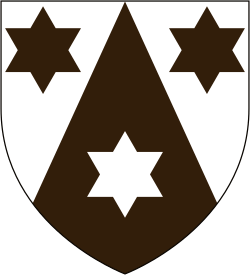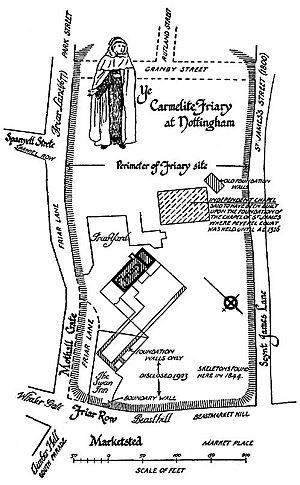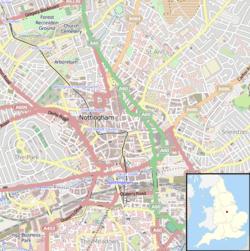Nottingham Whitefriars facts for kids

Coat of arms of the Carmelite Order
|
|
| Monastery information | |
|---|---|
| Other names | Nottingham Carmelite Friary, Nottingham White Friary, Whitefriars, Nottingham |
| Order | Carmelite |
| Established | 1271 |
| Disestablished | 1539 |
| Site | |
| Location | Nottingham |
| Coordinates | 52°57′09″N 1°09′07″W / 52.952631°N 1.15184°W |
| Visible remains | None |
Nottingham Whitefriars was a former Carmelite monastery in Nottingham, England. Monasteries like this were homes for groups of religious people called friars. The Carmelites were known as "White Friars" because of the white cloaks they wore over their brown habits.
History of the Friary

The Nottingham Whitefriars friary was built sometime before 1271. Some people thought it was founded later, but records show it existed earlier. For example, in 1272, King Henry III gave the friars 10 oak trees to help them fix their church.
The land for the friary might have been a gift from Reginald de Grey. In 1319, King Edward II confirmed that de Grey had given two pieces of land. These plots were next to each other, one in the "French borough of Nottingham" and another on St. James's Lane.
The people of Nottingham seemed to like the friary. Many local families and individuals donated land and buildings nearby. This helped the friary grow its property. In October 1319, Hugh de Bingham also donated a large piece of land, about 80 feet by 60 feet.
King Edward II really liked the friary. In 1319, he even freed the friars from paying a yearly rent to the crown. He did this "on account of the special affection that we have and bear to the said prior and brethren." In 1316, while visiting Clipston, Nottinghamshire, the King also gave the friary the Chapel of Saint James. This chapel was next to their friary and used to belong to Lenton Priory.
In October 1393, Henry de Whitley sought sanctuary at the friary after a serious incident. As long as he stayed inside the church, he could not be arrested. However, his belongings were taken by the Nottingham town authorities.
Notable Friars
The friary was home to two important friars in the 1300s. Philip Baston of Nottingham, who passed away in 1320, was a famous poet and speaker. He studied philosophy and theology at Oxford University.
John Clipston of Nottingham, who passed away in 1378, was a respected teacher and writer. He was a professor of theology at Cambridge University. He was buried at the friary in Nottingham.
Royal Visits and Dissolution
King Henry VIII visited the friary in August 1511. He made an offering at a special cross called the "Rood of the White Friars."
The friary was eventually closed down as part of King Henry VIII's dissolution of the monasteries. This was a time when many monasteries across England were shut down. The Nottingham Whitefriars friary was officially surrendered by its leader, Prior Roger Cappe, on February 5, 1539. At that time, six friars lived there.
After the friary closed, its land was given to James Sturley of Nottingham in 1541.
What's Left Today?
Sadly, nothing remains of the original friary buildings today. It used to stand near the southwest corner of Old Market Square in Nottingham. The area where the friary once was is now completely built over with modern buildings. However, its memory lives on in the street name "Friar Lane."
In 1923, during road work to make Friar Lane wider, some parts of the old friary were found. Most of these remains were covered up quickly as the new road was built. However, a small eastern part of the ruins was documented before new buildings were constructed.
Near Friars Row, workers found parts of a rectangular building with thick walls. It had floors made of decorative encaustic tiles. They also found a section of the old friary wall, about 2 feet thick, and several skeletons.


